Family Tachinidae (Bristled Flies, Tachinids)
Superfamily Oestroidea. Family Tachinidae
Tachinidae are a large and cosmopolitan family of flies within the superfamily Oestroidea.
There are well over 100 families in the order Diptera, and most of them are comprised entirely of species with free-living larvae. There are, however, about 20 families with at least some species classed as parasitoids, species that live within other animals as larvae and kill their hosts before progressing on to the adult stage. About 16,000 of the approximately 120,000 described species of Diptera are parasitoids, and about 10,000 of them belong to a single family, the Tachinidae. The Tachinidae are a large cosmopolitan family of flies that are parasitoids of other arthropods, primarily other insects, including important insect pests in agriculture.
Tachinid larvae feed on the host tissues, either after having been injected into the host by the parent, or penetrating the host from outside. Various species have different modes of oviposition and of host invasion. Typically, Tachinid larvae are endoparasites (internal parasites) of caterpillars of butterflies and moths, or the larvae of sawflies. For example, they have been found to lay eggs in African sugarcane borer larva, a species of moth common in sub-Saharan Africa.
Probably the majority of female Tachinids lay eggs onto the skin of the host insect. Some genera are effectively ovoviviparous (ovolarviparous) and deposit a hatching larva onto the host. The free larvae immediately bore into the host's body. Many other species inject eggs into the host's body, using the extensible, penetrating part of their ovipositor, sometimes called the oviscapt.
Another reproductive strategy is to leave the eggs in the host's environment, for example the female might lay on leaves, where the host is likely to ingest them. Some tachinids that are parasitoids of stem-boring caterpillars deposit eggs outside the host's burrow, letting the first instar larvae do the work of finding the host for themselves. In other species, the maggots use an ambush technique, waiting for the host to pass and then attacking it and burrowing into its body.
Adult Tachinids are not parasitic, but either do not feed at all or visit flowers, decaying matter, or similar sources of energy to sustain themselves until they have concluded their procreative activities.
Tachinid flies range in size from 2 to 20 mm, and most of them are larger than a house fly and noticeably more robust and more bristly, especially on thoracic dorsum and third to fifth abdominal segments; however, across the family there is a tremendous variety of shapes, colors, and degree of bristling. Some are brilliantly colored and resemble blow-flies (Calliphoridae). Most however are rather drab, some resembling house flies.
They have three-segmented antennae. They are aristate flies, and the arista usually is bare, though sometimes plumose. The calypters (small flaps above the halteres) are usually very large. Their median vein bends away sharply. In addition to features shared with other families of the super family Oestroidea (Rhinophoridae, Sarcophagidae, Calliphoridae, and Oestridae), adult tachinids can be recognized by the developed postscutellum bulging beneath the scutellum (a segment of the mesonotum).
Wing venation is a very important part of keying any tachinid: http://tachinidae.org.uk/blog/?page_id=809
The Tachinidae are by far the largest family of Afrotropical Diptera in terms of genera. The family is divided into four subfamilies: Dexiinae, Exoristinae, Phasiinae, and Tachininae. There are 237 genera, of which 101 (43%) are endemic to the region. Of the 1126 species recorded, a total of 1043 (93%) are endemic.
Insects in this family commonly are called tachinid flies or bristled flies.
Links:
Annals of the Natal Museum - Annotated keys to the genera of Tachinidae: https://journals.co.za/content/annals/2 ... 040798_481
Annotated catalogue of the Tachinidae (Insecta, Diptera) of the Afrotropical Region https://www.ncbi.nlm.nih.gov/pmc/articles/PMC4829880/
Africa Wild Insect Book Flies (Diptera)
Moderator: Klipspringer
-
Klipspringer
- Global Moderator
- Posts: 5858
- Joined: Sat Sep 14, 2013 12:34 pm
- Country: Germany
- Contact:
-
Klipspringer
- Global Moderator
- Posts: 5858
- Joined: Sat Sep 14, 2013 12:34 pm
- Country: Germany
- Contact:
Re: Africa Wild Insect Book Flies Photos & Descriptions
Tachinid Fly Mintho cf. flavicoxa
Superfamily Oestroidea. Family Tachinidae. Subfamily Tachininae. Tribe Minthoini
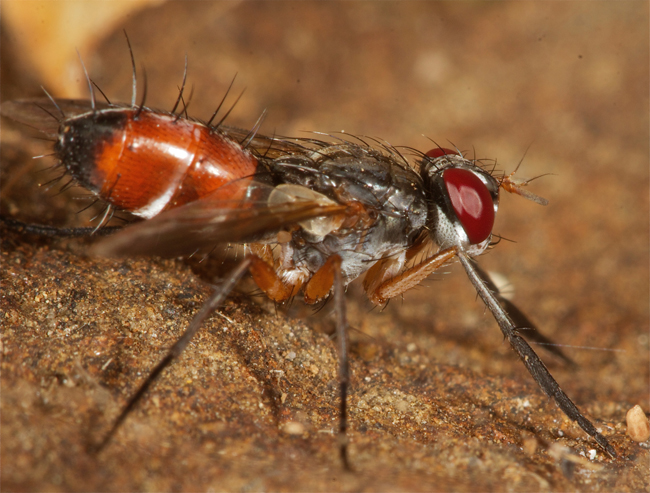 © ExFmem
© ExFmem
 © ExFmem
© ExFmem
Kruger National Park
Genus Mintho Robineau-Desvoidy 1830
Red abdominal side-patches, silvery face, long costal spine, shaded wings with a small petiole on the median vein.
Two broad longitudinal black bars on the thorax and the abdomen laterally compressed (higher than it is wide), tapering to the tip and about as long as the head+thorax; strong median discal bristles present; wing with very short petiole.
Mintho look very similar Cylindromyia but are distinguished from that by the abdomen not being truly cylindrical but rather laterally flattened.
The genus comprises only three species recorded from the Afrotropical region:
Mintho argentea Bezzi, 1908 (Botswana, D.R. Congo, Eritrea, Ethiopia, Kenya, Sudan, Uganda)
Mintho compressa, Fabricius, 1787 (Palaearctic and Afrotropical: D.R. Congo, Eritrea, Kenya, Nigeria, Somalia, South Africa, Sudan, Tanzania).
Mintho flavicoxa Bezzi, 1911 (D.R. Congo, Ethiopia, Ghana, Kenya, Malawi, Namibia, Nigeria, Sierra Leone, South Africa, Tanzania, Uganda, Zimbabwe)
Mintho flavicoxa is identified by the orange frontal coxa - as suggested by the name.
Superfamily Oestroidea. Family Tachinidae. Subfamily Tachininae. Tribe Minthoini
 © ExFmem
© ExFmem © ExFmem
© ExFmemKruger National Park
Genus Mintho Robineau-Desvoidy 1830
Red abdominal side-patches, silvery face, long costal spine, shaded wings with a small petiole on the median vein.
Two broad longitudinal black bars on the thorax and the abdomen laterally compressed (higher than it is wide), tapering to the tip and about as long as the head+thorax; strong median discal bristles present; wing with very short petiole.
Mintho look very similar Cylindromyia but are distinguished from that by the abdomen not being truly cylindrical but rather laterally flattened.
The genus comprises only three species recorded from the Afrotropical region:
Mintho argentea Bezzi, 1908 (Botswana, D.R. Congo, Eritrea, Ethiopia, Kenya, Sudan, Uganda)
Mintho compressa, Fabricius, 1787 (Palaearctic and Afrotropical: D.R. Congo, Eritrea, Kenya, Nigeria, Somalia, South Africa, Sudan, Tanzania).
Mintho flavicoxa Bezzi, 1911 (D.R. Congo, Ethiopia, Ghana, Kenya, Malawi, Namibia, Nigeria, Sierra Leone, South Africa, Tanzania, Uganda, Zimbabwe)
Mintho flavicoxa is identified by the orange frontal coxa - as suggested by the name.
Re: Africa Wild Insect Book Flies (Diptera)
Blowfly, “Highwayman Fly" Bengalia sp.
Superfamily Oestroidea Family Calliphoridae Subfamily Bengaliinae Tribe Bengaliini

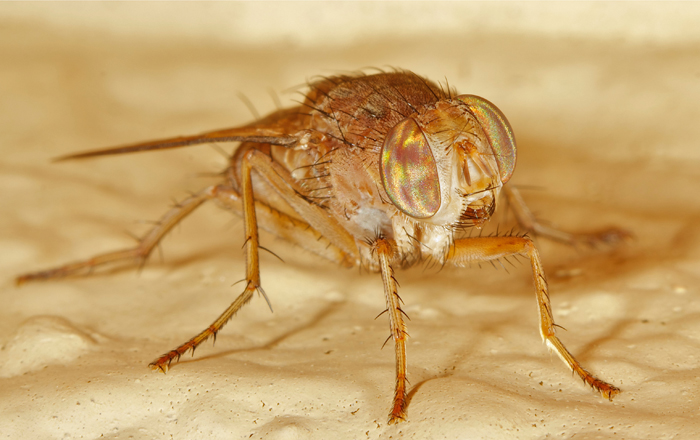
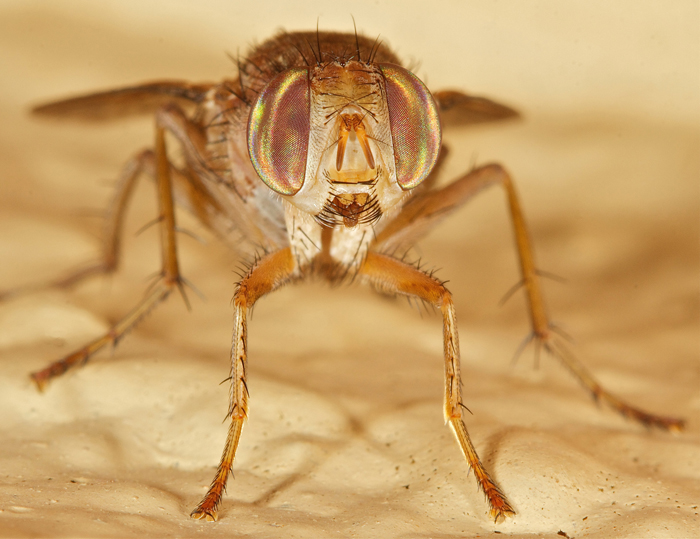
Kruger by ExFem (female)
The genus of blow flies Bengalia includes more than 70 species, which are found in the world's African and Asian tropics.
Six species recorded from South Africa: Bengalia walkeriana, B. racovitzai, B. cuthbertsoni, B. depressa, B. floccosa, B. peuhi.
Most of the species have a yellow or brown ground-colour, an antero-posteriorly compressed head with elongate eyes, stout mouthparts, a projecting clypeus below the lower facial margin and have a silent flight.
Habitat
Subtropical forest floor
Biology
Adults are predaceous on the prey of ants, hence the name “Highwayman Fly". Bengalia flies are best known for their remarkable highwayman‐like habit of stealing ant eggs, larvae, and pupae, as well as various prey being transported by the ant workers. The flies also attack termite workers emerging from damaged nests.
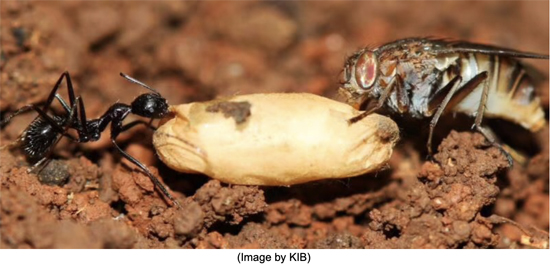
(Photo: Kumming Institute of Botany, CAS: http://english.kib.cas.cn/ns/es/201906/ ... 11057.html)
Distribution
Afrotropical, Oriental, immigrant Australasian
Note: “I recommend study of the genitalia before attempting identification of any Afrotropical Bengalia specimens.” https://www.biotaxa.org/Zootaxa/article ... .1.1/44402
https://pdfs.semanticscholar.org/653c/0 ... 1590517449
Superfamily Oestroidea Family Calliphoridae Subfamily Bengaliinae Tribe Bengaliini



Kruger by ExFem (female)
The genus of blow flies Bengalia includes more than 70 species, which are found in the world's African and Asian tropics.
Six species recorded from South Africa: Bengalia walkeriana, B. racovitzai, B. cuthbertsoni, B. depressa, B. floccosa, B. peuhi.
Most of the species have a yellow or brown ground-colour, an antero-posteriorly compressed head with elongate eyes, stout mouthparts, a projecting clypeus below the lower facial margin and have a silent flight.
Habitat
Subtropical forest floor
Biology
Adults are predaceous on the prey of ants, hence the name “Highwayman Fly". Bengalia flies are best known for their remarkable highwayman‐like habit of stealing ant eggs, larvae, and pupae, as well as various prey being transported by the ant workers. The flies also attack termite workers emerging from damaged nests.

(Photo: Kumming Institute of Botany, CAS: http://english.kib.cas.cn/ns/es/201906/ ... 11057.html)
Distribution
Afrotropical, Oriental, immigrant Australasian
Note: “I recommend study of the genitalia before attempting identification of any Afrotropical Bengalia specimens.” https://www.biotaxa.org/Zootaxa/article ... .1.1/44402
https://pdfs.semanticscholar.org/653c/0 ... 1590517449
-
Klipspringer
- Global Moderator
- Posts: 5858
- Joined: Sat Sep 14, 2013 12:34 pm
- Country: Germany
- Contact:
Re: Africa Wild Insect Book Flies Photos & Descriptions
Mariobezzine Bee Fly cf. Hyperusia sp.
Family Bombyliidae. Subfamily Mariobezzinae.
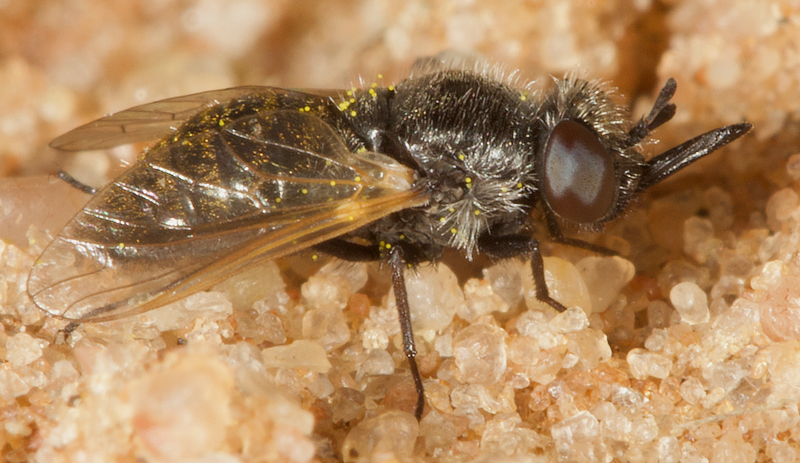
Kgalagadi Transfrontier Park © ExFmem
Subfamily Mariobezzinae:
All members of the subfamily are robust, compact flies, often bee-like in appearance, usually encountered resting in flowers, particularly daisy-like flowers of certain Asteraceae. Individuals tend to become covered in pollen grains which become entangled in the hair. The females have a well-developed sand chamber.
Diagnosis:
- Head much broader than high when viewed from front
- Eyes without an indentation on the posterior margin or any indication of a bisecting line
- Clypeus not reaching antennal sockets
- Antennae separated by not more than the length of scape and pedicel; scape with a short dorsal spine
- R2+3 always arises at an acute angle close to the origin of R.
- Body short and broad
Genus Hyperusia:
This genus is similar in appearance to Corsomyza but with a different distribution pattern. The species are found principally outside the winter-rainfall region of southern Africa, where Corsomyza spp. predominate, in tropical southern Africa. Sexual dimorphism is prominent in this genus.
Distribution: Afrotropical Region. South Africa, Namibia, Botswana: 8 species
South African species: Hyperusia luteifacies, H. minor, H. transvaalensis
Namibian species: Hyperusia longirostris, H. muscoides, H. soror, H. xantholeuca
Diagnosis:
- Head without frons inflated or face long and tumid
- No facial brush of stiff hairs
- Oral rim not raised into a prominent ridge
- Proboscis much shorter than head and thorax combined
- Antennae inserted immediately above oral rim
- Interradial crossvein usually absent (2 submarginal cells); cell cup closed or only narrowly open, anal lobe broad, alula well developed
- Plumula (= fringed posteroventral extension of subalar scerite) present ; hair tuft present behind metathoracic spiracle
- Body with dense adpressed scale-like hairs
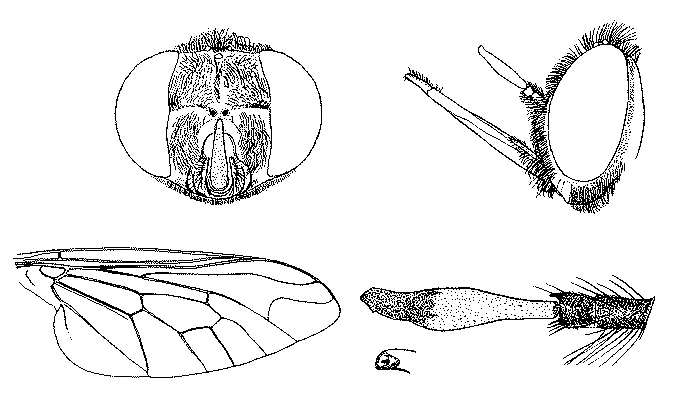
Links:
Bee flies of the world: the genera of the family Bombyliidae. 1973. Hull, Frank M. https://archive.org/stream/beefliesofwo ... 4/mode/1up
Annotated keys to the genera of African Bombylioidea (Diptera: Bombyliidae; Mythicomyiidae) by D. J. Greathead and N. L. Evenhuis
https://journals.co.za/content/nmsa_ai/42/1/EJC84477
Family Bombyliidae. Subfamily Mariobezzinae.

Kgalagadi Transfrontier Park © ExFmem
Subfamily Mariobezzinae:
All members of the subfamily are robust, compact flies, often bee-like in appearance, usually encountered resting in flowers, particularly daisy-like flowers of certain Asteraceae. Individuals tend to become covered in pollen grains which become entangled in the hair. The females have a well-developed sand chamber.
Diagnosis:
- Head much broader than high when viewed from front
- Eyes without an indentation on the posterior margin or any indication of a bisecting line
- Clypeus not reaching antennal sockets
- Antennae separated by not more than the length of scape and pedicel; scape with a short dorsal spine
- R2+3 always arises at an acute angle close to the origin of R.
- Body short and broad
Genus Hyperusia:
This genus is similar in appearance to Corsomyza but with a different distribution pattern. The species are found principally outside the winter-rainfall region of southern Africa, where Corsomyza spp. predominate, in tropical southern Africa. Sexual dimorphism is prominent in this genus.
Distribution: Afrotropical Region. South Africa, Namibia, Botswana: 8 species
South African species: Hyperusia luteifacies, H. minor, H. transvaalensis
Namibian species: Hyperusia longirostris, H. muscoides, H. soror, H. xantholeuca
Diagnosis:
- Head without frons inflated or face long and tumid
- No facial brush of stiff hairs
- Oral rim not raised into a prominent ridge
- Proboscis much shorter than head and thorax combined
- Antennae inserted immediately above oral rim
- Interradial crossvein usually absent (2 submarginal cells); cell cup closed or only narrowly open, anal lobe broad, alula well developed
- Plumula (= fringed posteroventral extension of subalar scerite) present ; hair tuft present behind metathoracic spiracle
- Body with dense adpressed scale-like hairs
Links:
Bee flies of the world: the genera of the family Bombyliidae. 1973. Hull, Frank M. https://archive.org/stream/beefliesofwo ... 4/mode/1up
Annotated keys to the genera of African Bombylioidea (Diptera: Bombyliidae; Mythicomyiidae) by D. J. Greathead and N. L. Evenhuis
https://journals.co.za/content/nmsa_ai/42/1/EJC84477
Re: Africa Wild Insect Book Flies (Diptera)
Red-eyed fly; “Bug‐killing fly” Phasia sp.
Family Tachinidae Subfamily Phasiinae Tribe Phasiini
The family Tachinidae is partially defined by the fact that all known species are arthropod parasitoids. A parasitoid possesses a unique lifestyle in which it develops within a living animal host, feeds off of it and eventually kills it in order to achieve adulthood.
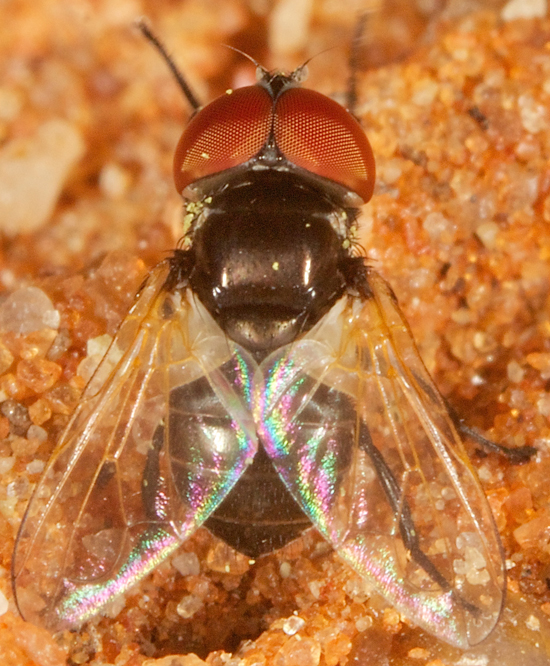
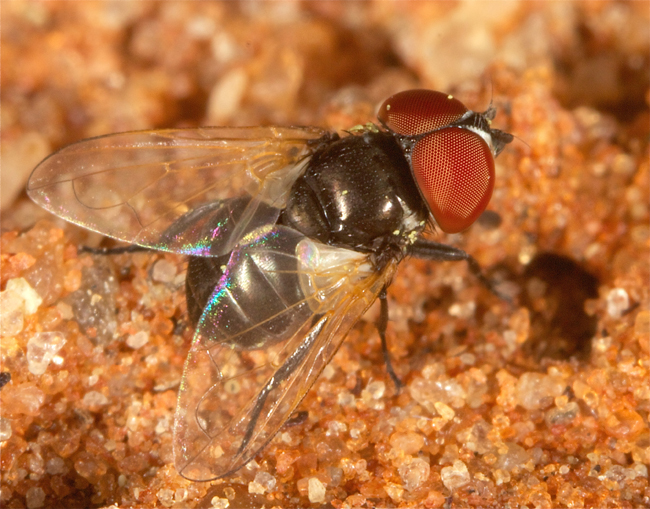
Kgalagadi TP by ExFmem
Subfamily Phasiinae
Phasiinae constitute the smallest of the four subfamilies of Tachinidae yet still contain over 600 described species belonging to about 100 genera.
Biology
The hosts of the subfamily Phasiinae are almost exclusively adults of true bugs (Hemiptera, suborder Heteroptera), including a multitude of agricultural pests, and are unusual among tachinid hosts in being highly mobile and protected by a hardened cuticle (in contrast to caterpillars and other larval Holometabola). Thus, they are colloquially referred to as the bug‐killing flies.
Another notable feature of many phasiines is their possession of piercing structures used to insert eggs into the bodies of hosts. Such piercers are adaptively beneficial since phasiines exploit adult hosts with hardened exoskeletons. Attaching an egg to the outside of the host requires the phasiine larvae to utilize powerful chitin-degrading proteins and/or specialized mandibles to break through the host’s exoskeleton. There is also substantial risk to the exposed egg of predation, desiccation and physical removal by the host. A piercer avoids these problems by bypassing the host’s cuticle.
Ecological Importance
At least some phasiines locate potential hosts through the use of specialized antennal receptors that are extremely sensitive to host pheromones. Remarkably, phasiines that have been tested for their ability to detect such pheromones were more sensitive to them than were the hosts themselves. Because of their distinctive ability to use pheromone cues, phasiines hold great promise as biological control agents but have been underutilized as such.
Genus Phasia
Identification
Phasia (Latreille) is a genus of robust tachinid flies with almost rounded, dorsally flattened abdomens, devoid of strong setae, and with a characteristic wing venation.
Wings: transparent (especially in females) or "smoky" patterned (especially in males), with distinctive venation: M1 curves forward distally and meet R4+5, with petiole longer than r-m; calypters conspicuously large.
Subscutellum very prominent and visible from above.
There are 9 spp of Phasia recorded from South Africa: P. africana, P. argentifrons, P. cana, P. distincta, P. nigromaculata, P. subnitida, P. transvaalensis, P. nasalis, P. nasuta.
https://onlinelibrary.wiley.com/doi/10.1111/syen.12272
https://www.ncbi.nlm.nih.gov/pmc/articles/PMC4829880/
Family Tachinidae Subfamily Phasiinae Tribe Phasiini
The family Tachinidae is partially defined by the fact that all known species are arthropod parasitoids. A parasitoid possesses a unique lifestyle in which it develops within a living animal host, feeds off of it and eventually kills it in order to achieve adulthood.


Kgalagadi TP by ExFmem
Subfamily Phasiinae
Phasiinae constitute the smallest of the four subfamilies of Tachinidae yet still contain over 600 described species belonging to about 100 genera.
Biology
The hosts of the subfamily Phasiinae are almost exclusively adults of true bugs (Hemiptera, suborder Heteroptera), including a multitude of agricultural pests, and are unusual among tachinid hosts in being highly mobile and protected by a hardened cuticle (in contrast to caterpillars and other larval Holometabola). Thus, they are colloquially referred to as the bug‐killing flies.
Another notable feature of many phasiines is their possession of piercing structures used to insert eggs into the bodies of hosts. Such piercers are adaptively beneficial since phasiines exploit adult hosts with hardened exoskeletons. Attaching an egg to the outside of the host requires the phasiine larvae to utilize powerful chitin-degrading proteins and/or specialized mandibles to break through the host’s exoskeleton. There is also substantial risk to the exposed egg of predation, desiccation and physical removal by the host. A piercer avoids these problems by bypassing the host’s cuticle.
Ecological Importance
At least some phasiines locate potential hosts through the use of specialized antennal receptors that are extremely sensitive to host pheromones. Remarkably, phasiines that have been tested for their ability to detect such pheromones were more sensitive to them than were the hosts themselves. Because of their distinctive ability to use pheromone cues, phasiines hold great promise as biological control agents but have been underutilized as such.
Genus Phasia
Identification
Phasia (Latreille) is a genus of robust tachinid flies with almost rounded, dorsally flattened abdomens, devoid of strong setae, and with a characteristic wing venation.
Wings: transparent (especially in females) or "smoky" patterned (especially in males), with distinctive venation: M1 curves forward distally and meet R4+5, with petiole longer than r-m; calypters conspicuously large.
Subscutellum very prominent and visible from above.
There are 9 spp of Phasia recorded from South Africa: P. africana, P. argentifrons, P. cana, P. distincta, P. nigromaculata, P. subnitida, P. transvaalensis, P. nasalis, P. nasuta.
https://onlinelibrary.wiley.com/doi/10.1111/syen.12272
https://www.ncbi.nlm.nih.gov/pmc/articles/PMC4829880/
Re: Africa Wild Insect Book Flies (Diptera)
Red-eyed fly; “Bug‐killing fly” Phasia sp.
Family Tachinidae Subfamily Phasiinae Tribe Phasiini
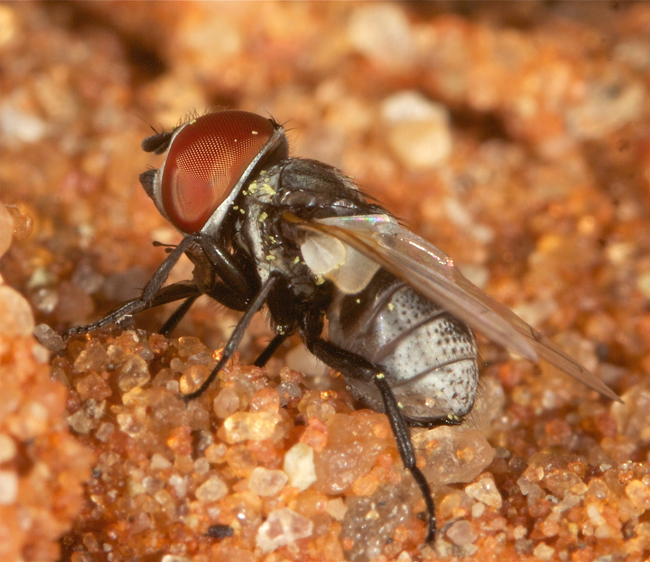
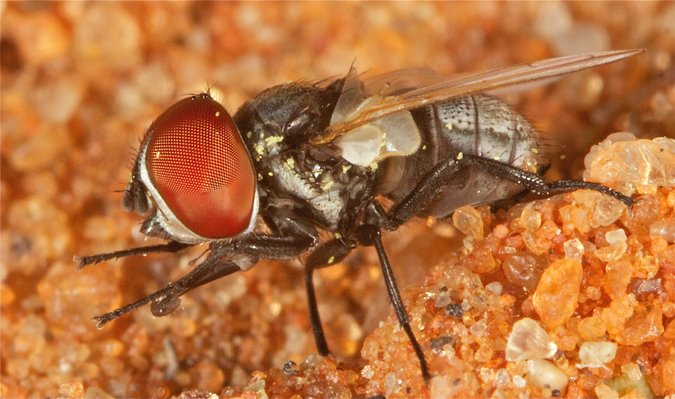
Kgalagadi TP by ExFmem
Description of Phasiinae and Phasia can be found here: https://africawild-forum.com/viewtopic. ... 73#p503273
Family Tachinidae Subfamily Phasiinae Tribe Phasiini


Kgalagadi TP by ExFmem
Description of Phasiinae and Phasia can be found here: https://africawild-forum.com/viewtopic. ... 73#p503273
Re: Africa Wild Insect Book Flies (Diptera)
Hunter fly Lispe cf. zumpti
Family Muscidae Subfamily Coenosiinae Tribe Limnophorini
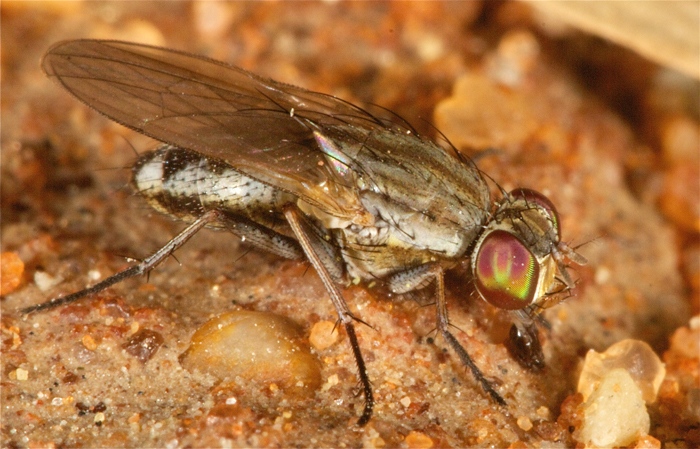
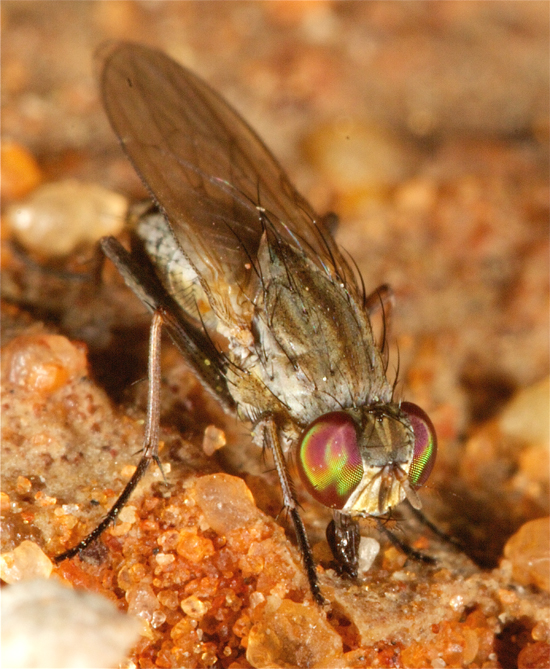
Kgalagadi TP by ExFmem
Genus Lispe
Diagnosis
Lispe Latreille, 1796 is a muscid genus of median body size and is recognized mainly by the following characters:
Frons broad in both sexes
Proboscis not adapted for piercing: sclerotised and retracted into head, with labella well developed and fleshy
Palpus greatly enlarged in apical part, spoon-like
Antenna inserted below mid level of eye;
Presutural dorsocentral setae well developed
Katepisternal setae 1:1 or 1:2.
Parafacial with setulae
Upper orbital setae 2
Anepimeron setulose
Lower calypter: inner margin diverging immediately and at right-angles from supra-squamal ridge; tongue-like in shape
All wing veins bare
Distribution
The genus has a worldwide distribution, being found in all zoogeographical regions with the exception of New Zealand, and has a diversity estimated at about 200 species by Vikhrev (2014). It is represented by 50 species in the Afrotropical Region, 15 of which have been recorded from South Africa.
Biology
Both in larval and adult stages, Lispe flies are commonly found near waterbodies, both flowing and standing, (from salty to fresh), acting as aggressive predators of small insects and other soft-bodied invertebrates, but most especially of mosquitoes. The adult flies are commonly seen resting on stones or running around on mud and sand, searching for mating partners or prey. Lispe larvae develop in wet sand or mud with high organic content.
Lispe zumpti
Description
Antennae light brown dusted, the second segment darker than the third
Legs: coxae light grey; femora grey, darker dorsally and apically; tibiae yellow in ground but the anterior pair infuscate except basally, the posterior pair somewhat infuscate apically; tarsi all black.
Abdomen slender and oval in shape; dorsum shining black with 3 lateral white emarginations on the segmental lines, these white areas run into the grey of the venter. The black on tergite three extends further ventrally than on the other segments.
Female: Abdomen less slender and the dorsum less intensely black; a median vitta is present on at least the second and third segments and at times on all four. The grey of the sides and venter of the abdomen is at times tinged with brown.
An extensive description of the species can be found here: *
*https://journals.co.za/content/JESSA/16
https://www.researchgate.net/publicatio
http://digitallibrary.amnh.org/bitstrea
Family Muscidae Subfamily Coenosiinae Tribe Limnophorini


Kgalagadi TP by ExFmem
Genus Lispe
Diagnosis
Lispe Latreille, 1796 is a muscid genus of median body size and is recognized mainly by the following characters:
Frons broad in both sexes
Proboscis not adapted for piercing: sclerotised and retracted into head, with labella well developed and fleshy
Palpus greatly enlarged in apical part, spoon-like
Antenna inserted below mid level of eye;
Presutural dorsocentral setae well developed
Katepisternal setae 1:1 or 1:2.
Parafacial with setulae
Upper orbital setae 2
Anepimeron setulose
Lower calypter: inner margin diverging immediately and at right-angles from supra-squamal ridge; tongue-like in shape
All wing veins bare
Distribution
The genus has a worldwide distribution, being found in all zoogeographical regions with the exception of New Zealand, and has a diversity estimated at about 200 species by Vikhrev (2014). It is represented by 50 species in the Afrotropical Region, 15 of which have been recorded from South Africa.
Biology
Both in larval and adult stages, Lispe flies are commonly found near waterbodies, both flowing and standing, (from salty to fresh), acting as aggressive predators of small insects and other soft-bodied invertebrates, but most especially of mosquitoes. The adult flies are commonly seen resting on stones or running around on mud and sand, searching for mating partners or prey. Lispe larvae develop in wet sand or mud with high organic content.
Lispe zumpti
Description
Antennae light brown dusted, the second segment darker than the third
Legs: coxae light grey; femora grey, darker dorsally and apically; tibiae yellow in ground but the anterior pair infuscate except basally, the posterior pair somewhat infuscate apically; tarsi all black.
Abdomen slender and oval in shape; dorsum shining black with 3 lateral white emarginations on the segmental lines, these white areas run into the grey of the venter. The black on tergite three extends further ventrally than on the other segments.
Female: Abdomen less slender and the dorsum less intensely black; a median vitta is present on at least the second and third segments and at times on all four. The grey of the sides and venter of the abdomen is at times tinged with brown.
An extensive description of the species can be found here: *
*https://journals.co.za/content/JESSA/16
https://www.researchgate.net/publicatio
http://digitallibrary.amnh.org/bitstrea
Re: Africa Wild Insect Book Flies (Diptera)
Rock Fly Cestrotus sp.
Family Lauxaniidae Subfamily Homoneurinae
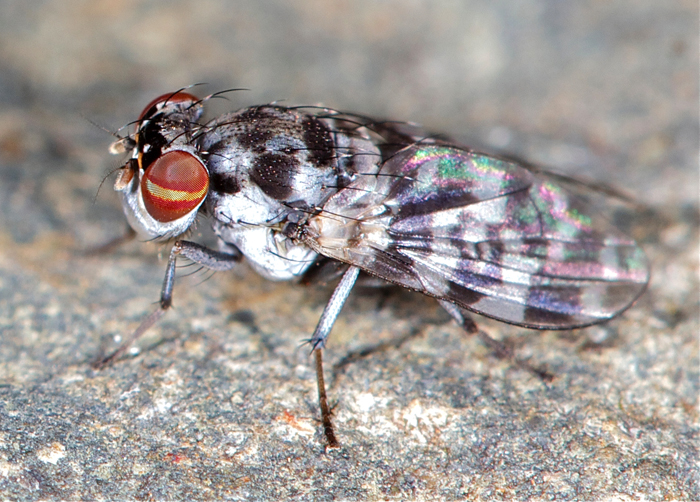
Kruger NP by ExFmem
Family Lauxaniidae
Description
The Lauxaniidae are a family of acalyptrate flies (do not possess calypters - a membranous flap that is located at the base of the wing). They generally are small flies (length 7 mm or less) with large compound eyes that often are brightly coloured in life, sometimes with characteristic horizontal stripes, such as in Cestrotus species. Many species have variegated patterns on their wings, but in contrast they generally do not have variegated bodies, except for genera such as Cestrotus, whose camouflage mimics lichens or the texture of granitic rocks.
Distribution
Some 1800 species of Lauxaniidae have been described and they comprise some 126 genera. The family has a cosmopolitan distribution, most of the species occurring in tropical regions of Asia and the Americas; relatively few species occur in Afrotropical regions, and Lauxaniid species diversity declines strongly towards the more temperate regions; for example fewer than 200 European species have been described.
Biology
Most species inhabit forests, where the adults usually are found sitting on leaves of the understory. They are far less common in open country, such as grassland habitats.
The larvae are mostly saprophagous, feeding in leaf litter, soil, bird nests, etc., so are important and necessary to ecosystem function. Because of this, they are a potential biological indicator of environmental changes.
Genus Cestrotus
Description
The genus is easily recognized by the following characters:
* body mostly grayish or brownish
* head elongate in vertical axis; frons slightly or strongly humped with ornamental spots and pollinosity (sometimes absent), the spots wider than long; anterior or reclinate; face and gena ventrally extended, with face prominently convex and with 1 strong genal bristle below eye; arista plumose or pubescent
*mesoscutum with distinct brown or black spots; 0+3 dc
* legs yellow, with brown rings
*wing with irregular grayish or brownish spots, and with setulae on some veins (absent in Oriental species).
Distribution
The genus Cestrotus Loew is distributed in the Oriental and Afrotropical Regions. Recorded South Africa species: Cestrotus striatus, Cestrotus turrets, Cestrotus variegatus, Cestrotus megacephalus, Cestrotus oculatus, Cestrotus pictipennis, Cestrotus polygrammus
Biology
Species of Cestrotus tend to frequent shady forests, crawling about on rocks or on tree trunks, and it has been more anecdotally noted among collectors that they frequent rocks along creeks and rivers or other moist, shady areas in forests.
https://species.nbnatlas.org/species/NBNSYS0000160279
https://bie.ala.org.au/species/urn:lsid ... 7043128244
https://www.researchgate.net/publicatio ...
Family Lauxaniidae Subfamily Homoneurinae

Kruger NP by ExFmem
Family Lauxaniidae
Description
The Lauxaniidae are a family of acalyptrate flies (do not possess calypters - a membranous flap that is located at the base of the wing). They generally are small flies (length 7 mm or less) with large compound eyes that often are brightly coloured in life, sometimes with characteristic horizontal stripes, such as in Cestrotus species. Many species have variegated patterns on their wings, but in contrast they generally do not have variegated bodies, except for genera such as Cestrotus, whose camouflage mimics lichens or the texture of granitic rocks.
Distribution
Some 1800 species of Lauxaniidae have been described and they comprise some 126 genera. The family has a cosmopolitan distribution, most of the species occurring in tropical regions of Asia and the Americas; relatively few species occur in Afrotropical regions, and Lauxaniid species diversity declines strongly towards the more temperate regions; for example fewer than 200 European species have been described.
Biology
Most species inhabit forests, where the adults usually are found sitting on leaves of the understory. They are far less common in open country, such as grassland habitats.
The larvae are mostly saprophagous, feeding in leaf litter, soil, bird nests, etc., so are important and necessary to ecosystem function. Because of this, they are a potential biological indicator of environmental changes.
Genus Cestrotus
Description
The genus is easily recognized by the following characters:
* body mostly grayish or brownish
* head elongate in vertical axis; frons slightly or strongly humped with ornamental spots and pollinosity (sometimes absent), the spots wider than long; anterior or reclinate; face and gena ventrally extended, with face prominently convex and with 1 strong genal bristle below eye; arista plumose or pubescent
*mesoscutum with distinct brown or black spots; 0+3 dc
* legs yellow, with brown rings
*wing with irregular grayish or brownish spots, and with setulae on some veins (absent in Oriental species).
Distribution
The genus Cestrotus Loew is distributed in the Oriental and Afrotropical Regions. Recorded South Africa species: Cestrotus striatus, Cestrotus turrets, Cestrotus variegatus, Cestrotus megacephalus, Cestrotus oculatus, Cestrotus pictipennis, Cestrotus polygrammus
Biology
Species of Cestrotus tend to frequent shady forests, crawling about on rocks or on tree trunks, and it has been more anecdotally noted among collectors that they frequent rocks along creeks and rivers or other moist, shady areas in forests.
https://species.nbnatlas.org/species/NBNSYS0000160279
https://bie.ala.org.au/species/urn:lsid ... 7043128244
https://www.researchgate.net/publicatio ...
-
Klipspringer
- Global Moderator
- Posts: 5858
- Joined: Sat Sep 14, 2013 12:34 pm
- Country: Germany
- Contact:
Re: Africa Wild Insect Book Flies - Diptera, Muscomorpha, Muscoidea, Anthomyiidae
Root Maggot Flower Fly sp Anthomyia sp.
Infraorder Muscomorpha, Superfamily Muscoidea, Family Anthomyiidae
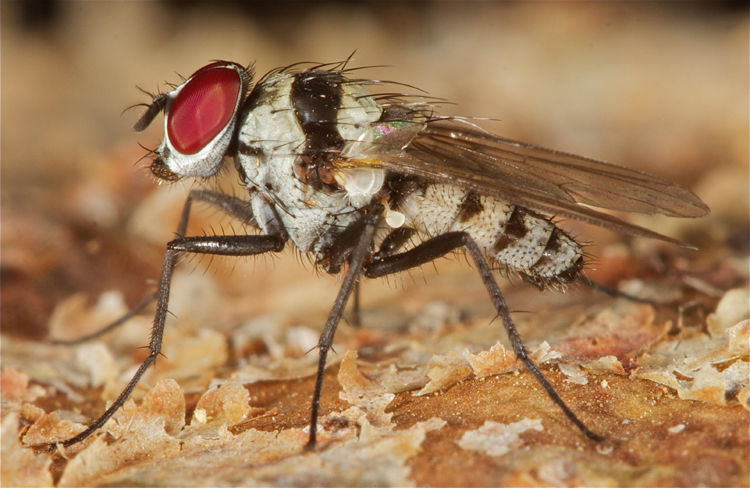 © ExFmem
© ExFmem
Male, Kruger National Park
Information here
Infraorder Muscomorpha, Superfamily Muscoidea, Family Anthomyiidae
 © ExFmem
© ExFmemMale, Kruger National Park
Information here
-
Klipspringer
- Global Moderator
- Posts: 5858
- Joined: Sat Sep 14, 2013 12:34 pm
- Country: Germany
- Contact:
Re: Africa Wild Insect Book Flies Photos & Descriptions
Oriental Latrine Fly Chrysomya megacephala
Family Calliphoridae
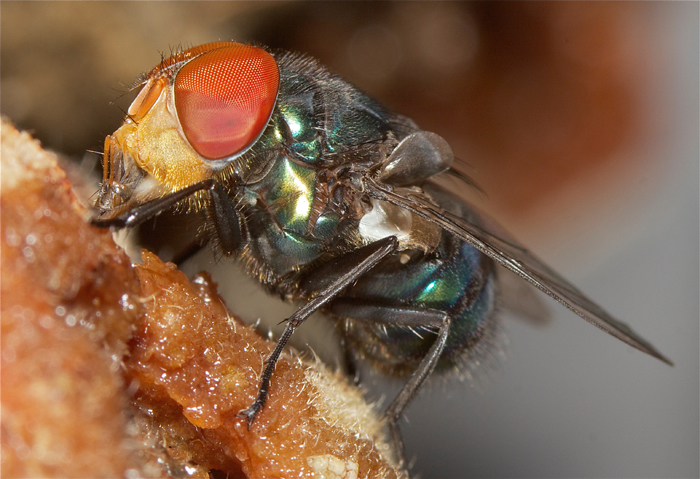 © ExFmem
© ExFmem
Male
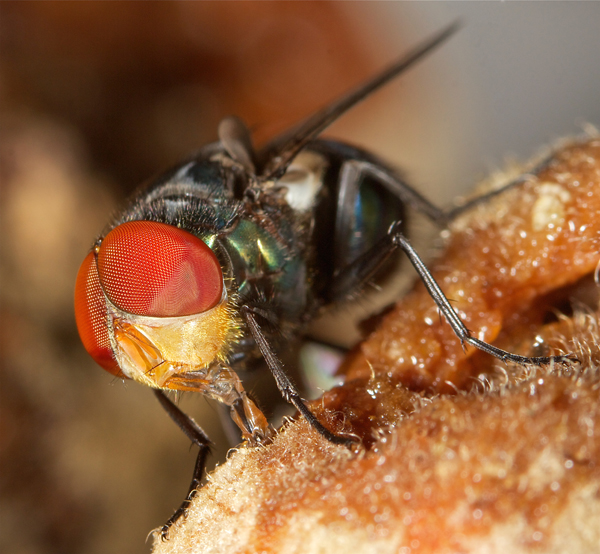 © ExFmem
© ExFmem
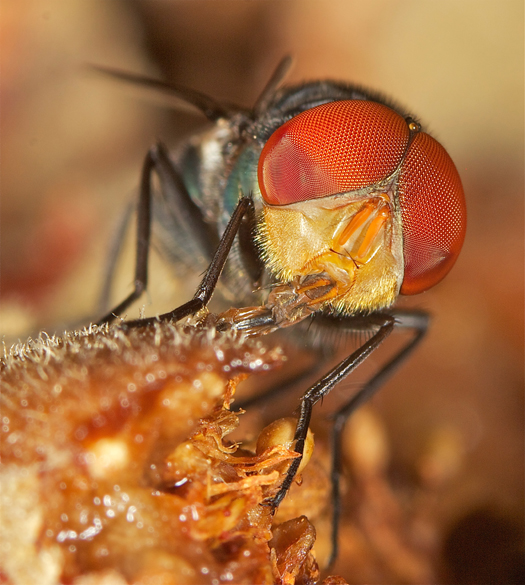 © ExFmem
© ExFmem
 © ExFmem
© ExFmem
Female and male
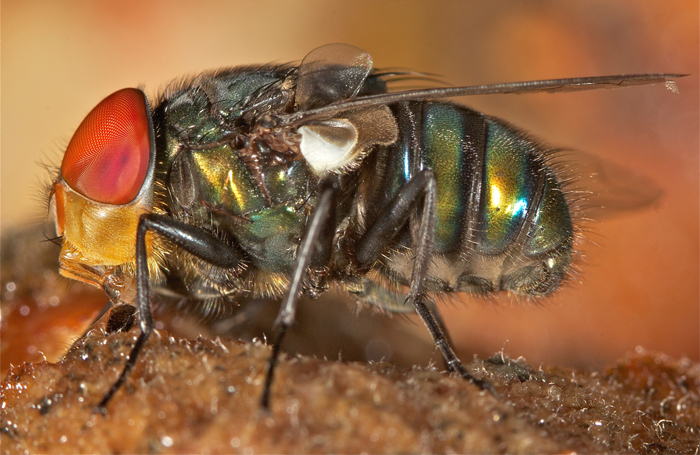 © ExFmem
© ExFmem
Kruger National Park
Description
Adult flies reflect a metallic blue-green color on their thorax and abdomen and have yellow gena, or cheeks. C. megacephala have large red eyes, those of males being close together, and those of females farther apart. The cercus of the male is longer than that of the female.
Identification:
- Anterior thoracic spiracle is black to dark brown.
- Eye in male sharply demarcated, upper facets strikingly large compared to lower ones;
- For both sexes, calypters mostly greyish-brown, except for contrasting white base to upper calypter.
- Female frons widening in middle, edges convex.
- Hyaline wing margin.
Distribution
Chrysomya megacephala has a wide geographical distribution. It is most common in the Oriental region and Australasia. Chrysomya megacephala was not originally present in Africa, but since the first records in the late 1970s has spread quickly and is now present in most of the continent.
Biology
Chrysomya megacephala is known as the ‘oriental latrine fly’ due to its habit of ovipositing in latrines and its probable origins in New Guinea. Larvae are also commonly found on human food and carrion. Due to this attraction to both faeces and food, it is considered to be a potential mechanical vector of faecal pathogens.
Links:
Checklist: The Blowflies (Diptera: Calliphoridae) of Southern Africa
https://www.researchgate.net/publicatio ... liphoridae
Family Calliphoridae
 © ExFmem
© ExFmemMale
 © ExFmem
© ExFmem © ExFmem
© ExFmem © ExFmem
© ExFmem Female and male
 © ExFmem
© ExFmemKruger National Park
Description
Adult flies reflect a metallic blue-green color on their thorax and abdomen and have yellow gena, or cheeks. C. megacephala have large red eyes, those of males being close together, and those of females farther apart. The cercus of the male is longer than that of the female.
Identification:
- Anterior thoracic spiracle is black to dark brown.
- Eye in male sharply demarcated, upper facets strikingly large compared to lower ones;
- For both sexes, calypters mostly greyish-brown, except for contrasting white base to upper calypter.
- Female frons widening in middle, edges convex.
- Hyaline wing margin.
Distribution
Chrysomya megacephala has a wide geographical distribution. It is most common in the Oriental region and Australasia. Chrysomya megacephala was not originally present in Africa, but since the first records in the late 1970s has spread quickly and is now present in most of the continent.
Biology
Chrysomya megacephala is known as the ‘oriental latrine fly’ due to its habit of ovipositing in latrines and its probable origins in New Guinea. Larvae are also commonly found on human food and carrion. Due to this attraction to both faeces and food, it is considered to be a potential mechanical vector of faecal pathogens.
Links:
Checklist: The Blowflies (Diptera: Calliphoridae) of Southern Africa
https://www.researchgate.net/publicatio ... liphoridae


